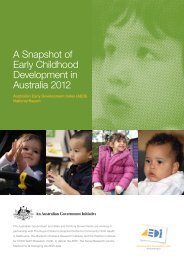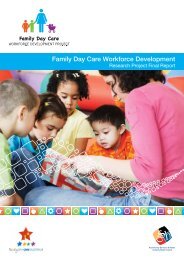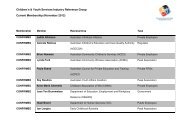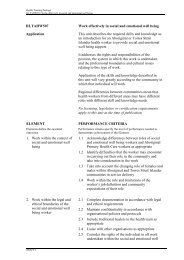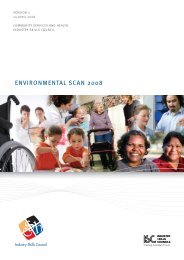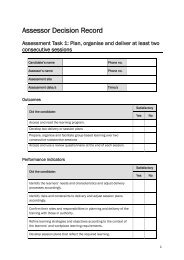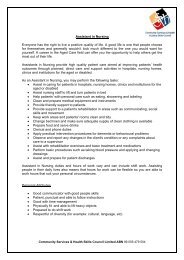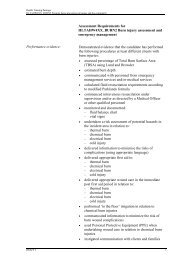2013 Environmental Scan - Community Services & Health Industry ...
2013 Environmental Scan - Community Services & Health Industry ...
2013 Environmental Scan - Community Services & Health Industry ...
You also want an ePaper? Increase the reach of your titles
YUMPU automatically turns print PDFs into web optimized ePapers that Google loves.
THE CARE INDUSTRY – A TIME FOR ACTION<br />
BROADER IMPACT OF<br />
TRAINING PACKAGES<br />
In our survey, nearly 90 per cent<br />
of respondents were aware of the<br />
<strong>Community</strong> <strong>Services</strong> and <strong>Health</strong> Training<br />
packages. Given the nature of the<br />
survey and the large proportion of RTOs<br />
participating, this figure is not surprising.<br />
The majority of industry stakeholders<br />
who report using the training packages<br />
do so for direct training purposes when<br />
employing trainees and conducting<br />
workplace assessments. There was much<br />
less evidence supporting the position that<br />
the training packages are being deployed<br />
to support other functions, such as<br />
supporting recruitment or job design.<br />
CS&HISC have been assisting eligible<br />
enterprises to access skills and workforce<br />
development programs and funding<br />
through the new Australian Government<br />
Skills Connect initiative which includes:<br />
ww<br />
National Workforce Development<br />
Fund (NWDF)<br />
ww<br />
Workplace English Language<br />
and Literacy Program<br />
ww<br />
Accelerated Australian<br />
Apprenticeships initiative<br />
ww<br />
Australian Apprenticeships<br />
Mentoring Program<br />
ww<br />
Investing in Experience Training<br />
ww<br />
Investing in Experience:<br />
More Help for Mature Age Workers.<br />
CS&HISC has also developed a<br />
Workforce Development Kit to assist<br />
organisations with the workforce planning<br />
process, which is a major component of a<br />
NWDF application. Brokerage of NWDF<br />
and Australian Government Skills Connect<br />
has enabled the CS&HISC to oversee<br />
over 100 projects with funding of $30<br />
million with individuals participating in<br />
training and the development of industry<br />
wide innovation projects.<br />
SUPPORTING WORK<br />
PLACEMENTS<br />
In 2011, HWA produced a National<br />
Clinical Supervision Support Framework<br />
(HWA 2011), which provides a framework<br />
for expanding capacity and competence<br />
in clinical supervision for VET and<br />
higher education roles in health. There<br />
is mounting anecdotal evidence that<br />
industry would like a greater emphasis on<br />
clinical placements and work experience<br />
as part of training package qualifications,<br />
and this is at odds with the shift to<br />
demand driven training models.<br />
Demand driven models may increase the<br />
number of students in community services<br />
and health, but there is no additional<br />
funding to boost the number of clinical<br />
placements to support those students.<br />
Finding time and resources to support<br />
clinical supervision in the workplace is<br />
increasingly difficult for sectors across<br />
the <strong>Community</strong> and <strong>Services</strong> <strong>Health</strong><br />
industry, as the move to demand driven<br />
funding continues. Without extra funding<br />
and support, there is a strong risk that<br />
demand for higher education student<br />
clinical placements will displace resources<br />
currently used for development and<br />
training of the existing VET workforce.<br />
This could potentially increase<br />
competition for supervision resources<br />
between Registered Nurse (RN) and<br />
Enrolled Nurse (EN) training. For example,<br />
if the cost of supplying supervision was<br />
fully incorporated into training, then it<br />
could lead to higher student fees or<br />
greater investment by Governments.<br />
The health system has made progress in<br />
the last twelve months in accommodating<br />
larger numbers of clinical placements,<br />
beginning with medical students. Growing<br />
numbers of trainee doctors have been<br />
placed into non-traditional (i.e. non<br />
hospital) internships in regional areas<br />
(Scott & Li, 2012). In November 2012,<br />
the Australian Government announced<br />
that it would directly fund up to 100<br />
internships in <strong>2013</strong> for student doctors in<br />
private hospitals to address a shortage of<br />
placements (Plibersek, 2012). CS&HISC<br />
would argue that placements for VET<br />
students require greater support to ensure<br />
they have the necessary workplace<br />
readiness skills on graduation.<br />
Broadly, clinical placements in health are<br />
being addressed by HWA who has set up<br />
30 regional clinical training networks. They<br />
have also set up a Clinical Training Funding<br />
program which has led to an increase of<br />
over 335,000 clinical training placement<br />
days, a growth of 19.1 per cent. The<br />
amount of funding for VET does not match<br />
that of higher education and there may<br />
be pressure on supply of placements for<br />
VET students. If the pressure from higher<br />
education occupations like RNs continues<br />
to build then further strategies will need to<br />
be identified to ensure VET occupations<br />
like ENs are not disadvantaged.<br />
Workplace supervision is much less<br />
entrenched in community services, both<br />
in terms of established practice and<br />
the allocation of resources. In 2011 the<br />
Australian Government began providing<br />
funding for capital and clinical placements<br />
to develop facilities in Launceston and<br />
Hobart into teaching aged care homes<br />
(ACSA, 2011). However, most of this<br />
activity continues to focus on higher<br />
education roles.<br />
Increasing levels of ATSI <strong>Health</strong> Workers<br />
proposed by <strong>Health</strong> Workforce Australia<br />
(HWA, 2011b) will require greater<br />
support at the workforce level. Providing<br />
additional resources to support mentoring<br />
of students in the workplace has clear<br />
payoffs. An example of a successful<br />
mentoring program is the Yarn Up – Tok<br />
Blo Yumi Project run through the <strong>Health</strong><br />
and <strong>Community</strong> <strong>Services</strong> Workforce<br />
Council in Queensland, with input from<br />
TAFE Queensland and the Indigenous<br />
Professional Support Unit (<strong>Health</strong> and<br />
<strong>Community</strong> <strong>Services</strong> Workforce Council<br />
2012:19). Systems and resources need<br />
to be in place to support new workers<br />
as well as students through mentoring<br />
(Victoria Department of <strong>Health</strong>, 2012).<br />
Mentoring systems not only reduce new<br />
staff from leaving, they also improve<br />
satisfaction among existing staff asked to<br />
be mentors, who see it as recognition of<br />
their contribution to the organisation and<br />
the industry (Ivanson and Knox 2007).<br />
But mentoring is not funded, because of<br />
workloads and job demands. Feedback<br />
from stakeholders is that experienced<br />
staff do not have the time to support new<br />
entrants, whether formally or informally,<br />
and this probably contributes to turnover<br />
and attrition.<br />
JOB REDESIGN<br />
In Section 2, we presented evidence that<br />
projections for the health and community<br />
services workforce assume that the current<br />
skills balance between higher education<br />
and VET roles can be maintained, even<br />
across a range of scenarios. Yet, as<br />
reported in Section 1, the fiscal situation of<br />
State governments are leading to a greater<br />
focus on how job roles in health (and to<br />
a lesser extent in community services)<br />
may be redesigned to allow for greater<br />
efficiency of current resources. This is<br />
a difficult debate and one where<br />
training packages play only a part.<br />
Without extra funding and support, there is a strong risk that<br />
demand for higher education student clinical placements<br />
will displace resources currently used for development and<br />
training of the existing VET workforce<br />
There is no consensus among<br />
stakeholders within the industry about<br />
how more efficient job design can<br />
be achieved. Key industry informants<br />
interviewed for the E<strong>Scan</strong> spoke of their<br />
need to be creative when addressing<br />
the gap between service requirements,<br />
funding and the availability of a skilled<br />
workforce. Many are looking to adopt<br />
HWA’s priorities, particularly discussions<br />
of job redesign for “generalists” in the<br />
allied health and health professions<br />
(HWA, 2011a).<br />
Stakeholder input for this E<strong>Scan</strong> identified<br />
frustrations at the lack of prestige that<br />
is associated with generalist positions<br />
in health and community services, and<br />
are working to progress vocational<br />
stream linkages between occupations,<br />
as a means of increasing much needed<br />
workforce capacity. CS&HISC will<br />
need to closely monitor this move to<br />
generalisation rather than specialisation<br />
as it will have a major impact not only<br />
on the industry but on our capacity to<br />
inform and receive feedback from our<br />
stakeholders and our training packages<br />
are up to date.<br />
ENVIRONMENTAL SCAN <strong>2013</strong> : SECTION THREE CURRENT IMPACT OF TRAINING PACKAGES<br />
30 31



